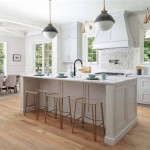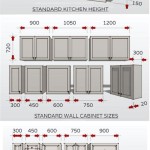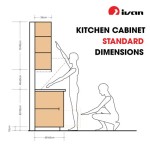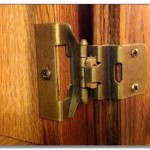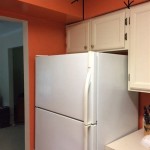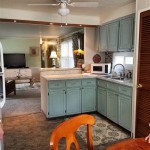Mid-Century Modern Kitchen Door Pulls: A Comprehensive Guide
Mid-Century Modern (MCM) kitchen design, an aesthetic defined by clean lines, functionality, and a seamless integration of indoor and outdoor spaces, remains a popular choice for homeowners. A crucial component of this design philosophy, often overlooked, is the cabinet and drawer hardware. Specifically, Mid-Century Modern kitchen door pulls contribute significantly to the overall visual appeal and practicality of the space. Selecting the right door pulls requires careful consideration of materials, shapes, finishes, and overall integration with the existing kitchen elements.
The essence of MCM design lies in its simplicity and elegance. Door pulls, therefore, should reflect this core principle. Excessive ornamentation or overly intricate designs clash with the minimalist aesthetic. Instead, focus should be placed on finding pulls that are streamlined, functional, and visually harmonious within the kitchen's context. This article will delve into the key aspects of selecting and incorporating authentic or reproduction Mid-Century Modern kitchen door pulls.
Materials and Finishes: Defining the MCM Aesthetic
The choice of materials and finishes is paramount when selecting door pulls for a Mid-Century Modern kitchen. Certain materials are distinctly characteristic of the era, while others, although contemporary, can be seamlessly integrated if chosen judiciously.
Wood:
Wood was a prominent material in MCM design, extending beyond furniture and architectural elements. Wooden door pulls, often crafted from teak, walnut, or other hardwoods, offer a warm and organic touch. These pulls frequently feature simple, elongated shapes or rounded, ergonomic designs. The natural grain of the wood adds texture and visual interest, complementing the clean lines of the cabinetry. However, wooden pulls require careful maintenance to prevent damage from moisture and cleaning agents.Metal:
Metal pulls, particularly those made from brushed nickel, stainless steel, or brass, are also highly representative of the MCM era. These metals provide a sleek, modern contrast against wood cabinets. Brushed nickel offers a subtle, understated elegance, while stainless steel provides a more industrial and durable option. Brass, whether polished or antiqued, adds a touch of warmth and sophistication. The shape of metal pulls ranges from simple bars and tubular designs to more sculpted, organic forms. The simplicity of metal pulls allowed for a focus on the material's inherent qualities and the overall cabinet design.Combination Materials:
Some MCM door pulls creatively combine materials, such as wood and metal or metal and plastic. These combinations offer a unique aesthetic and can add visual interest to the kitchen. For example, a wooden pull with metal accents or a metal pull with a colored plastic inlay can create a distinctive look. However, it is crucial to ensure that the materials and colors harmonize effectively and do not detract from the overall minimalist aesthetic.The finish of the door pulls is as important as the material. A polished finish will reflect more light and create a brighter, more contemporary look. A brushed finish will provide a more subdued and understated appearance. An antiqued finish can add a touch of vintage charm. Consider the existing hardware and lighting fixtures in the kitchen when selecting the finish to ensure a cohesive and harmonious design.
Shapes and Styles: Embracing Simplicity and Functionality
The shapes and styles of Mid-Century Modern door pulls are characterized by their simplicity, functionality, and ergonomic design. The emphasis is on clean lines, geometric forms, and comfortable usability, avoiding overly elaborate or ornate details.
Bar Pulls:
Bar pulls are a classic MCM choice, featuring a simple, elongated bar shape. These pulls are typically made from metal, such as stainless steel or brushed nickel, and offer a clean, contemporary look. The length of the bar pull can vary depending on the size of the cabinet or drawer, but generally, longer pulls are preferred for larger surfaces to provide a more balanced and visually appealing design. Bar pulls are highly functional and provide a comfortable grip for opening and closing cabinets and drawers.Tubular Pulls:
Tubular pulls, characterized by their rounded, cylindrical shape, are another popular choice for MCM kitchens. These pulls are often made from metal or wood and offer a softer, more organic look compared to bar pulls. The rounded shape is comfortable to grip and provides a smooth, tactile experience. Tubular pulls can be mounted horizontally or vertically, depending on the cabinet or drawer configuration. They are available in a variety of sizes and finishes to complement different kitchen styles.Lip Pulls:
Lip pulls, also known as edge pulls, are discreet and minimalist, attaching to the edge of the cabinet or drawer. They offer a clean, seamless look and are ideal for kitchens where the focus is on the cabinetry itself. Lip pulls are typically made from metal and are available in a variety of finishes. They can be recessed into the cabinet door or mounted on the surface, depending on the design. While lip pulls are visually appealing, they may not be as ergonomic as other types of pulls, especially for individuals with limited hand strength.Recessed Pulls:
Recessed pulls are designed to be flush with the surface of the cabinet or drawer, creating a completely seamless look. These pulls are typically made from metal or plastic and are available in a variety of shapes and sizes. Recessed pulls offer a clean, minimalist aesthetic and are ideal for kitchens where space is limited or where a clean, uncluttered look is desired. However, recessed pulls can be more challenging to grip and may not be suitable for all users.The selection of the appropriate shape and style should consider both aesthetics and functionality. The pulls should be comfortable to grip and easy to use, while also complementing the overall design of the kitchen. It is essential to test different pulls to ensure that they are a good fit for your hands and that they provide adequate leverage for opening and closing cabinets and drawers.
Integration with Kitchen Design: Creating a Cohesive Look
The final key point in selecting Mid-Century Modern kitchen door pulls is their integration with the overall kitchen design. The pulls should not only be aesthetically pleasing and functional but also complement the existing cabinetry, countertops, backsplash, and other hardware elements. A cohesive design creates a harmonious and visually appealing space.
Cabinetry Style:
The style of the cabinetry is a primary consideration when selecting door pulls. Flat-front cabinets, characteristic of MCM design, pair well with minimalist pulls such as bar pulls, tubular pulls, or lip pulls. Shaker-style cabinets, while not strictly MCM, can also be successfully integrated with MCM door pulls if the pulls are simple and understated. Avoid overly ornate or decorative pulls that clash with the clean lines of the cabinetry.Countertop Material:
The material and color of the countertops should also be considered when selecting door pulls. For example, if the countertops are made of a warm-toned material such as wood or granite, brass or wooden pulls can create a cohesive look. If the countertops are made of a cool-toned material such as stainless steel or quartz, stainless steel or brushed nickel pulls may be a better choice. The contrast between the countertop and the door pulls can also create visual interest, but it is important to ensure that the colors and materials complement each other.Backsplash Design:
The design of the backsplash should also be taken into account. If the backsplash is simple and understated, the door pulls can be more prominent and visually interesting. If the backsplash is more decorative and eye-catching, the door pulls should be more subtle and understated to avoid overwhelming the space. The colors and materials of the backsplash should also be considered when selecting the finish of the door pulls. For example, if the backsplash features metallic accents, metal pulls can help to tie the design together.Existing Hardware:
The existing hardware in the kitchen, such as faucets, lighting fixtures, and appliances, should also be considered when selecting door pulls. The finishes of the door pulls should complement the finishes of the other hardware elements to create a cohesive and harmonious look. Avoid mixing too many different finishes, as this can create a cluttered and disjointed appearance. Consistency in hardware finishes is a key element of MCM design.In conclusion, selecting the right Mid-Century Modern kitchen door pulls requires careful consideration of materials, shapes, finishes, and overall integration with the existing kitchen elements. By focusing on simplicity, functionality, and harmony, homeowners can create a kitchen that is both aesthetically pleasing and practical, reflecting the enduring appeal of MCM design.
Mid Century Peg Cabinet Knob Rejuvenation
Mid Century Peg Cabinet Knob Rejuvenation
Brand New Brass Hardware In Our Mid Century Kitchen Dream Green Diy
Dans Le Lakehouse Modern Kitchen Cabinet Handles Hardware
Brand New Brass Hardware In Our Mid Century Kitchen Dream Green Diy
Love It Or Mid Century Kitchen Hardware Merrypad
Wood Drawer Pull Lines Mid Century Modern Cabinet
Image For Mid Century Modern Drawer Pulls Drawers Best Kitchen Layout
Wood Mid Century Modern Cabinet Hardware Kitchen Forge Studio
Diy Midcentury Kitchen And Dining Renovation Mochi Mommy
Related Posts

